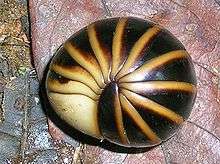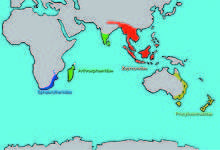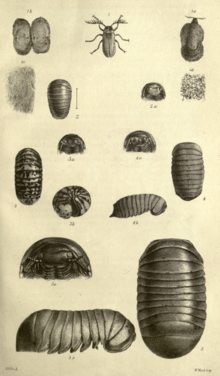Sphaerotheriida
| Sphaerotheriida | |
|---|---|
 | |
| Scientific classification | |
| Kingdom: | Animalia |
| Phylum: | Arthropoda |
| Class: | Diplopoda |
| Subclass: | Chilognatha |
| Infraclass: | Pentazonia |
| Superorder: | Oniscomorpha |
| Order: | Sphaerotheriida Brandt, 1833 |
| Families | |
| |
 | |
| Synonyms | |
| |
Sphaerotheriida (from the Latin sphaerium = ball) is an order of millipedes[1] in the infraclass Pentazonia,[2] sometimes known as giant pill millipedes. They inhabit Southern Africa, Madagascar, South and Southeast Asia, Australia and New Zealand.[3] Like the Northern Hemisphere pill millipedes of the order Glomerida, these millipedes can roll into a ball when disturbed. When they are rolled-up, most sphaerotheriidans reach a maximum size of a cherry [4] or golf ball,[5] but some species from Madagascar can even reach the size of an orange[6] (an example of island gigantism). When rolled-up, predators are unable to unravel giant pill millipedes since the margins of their second and last dorsal plates fit perfectly into one another, creating a sealed ball. A few giant pill millipede species are able to produce sound, the only millipedes known to do this.[7] This order of millipedes is also unique in that some African species are used for medicinal purposes.[8]
Morphology
Sphaerotheriidans are characterized by a relatively conservative body morphology; superficially all species and genera look the same.[3] Dorsally, their head is followed by twelve body tergites (collum, thoracic shield, and ten normal tergites) and the anal shield. Ventrally, females possess twenty-one leg pairs (forty-two legs in total), while males carry two additional modified leg pairs, the anterior and posterior telopods under their anal shield. The telopods resemble chelae and/or clamp-like structures, which are probably used in holding the female during mating.[3] In the position of the male telopods, the females instead have a sclerotized subanal plate, which in some species such as those belonging to the family Arthrosphaeridae, is enlarged and is used to produce vibrations (stridulation).[3] Furthermore, unlike other large-bodied millipede orders, Sphaerotheriida do not have glands that excrete poisonous or ill-smelling substances. Instead they depend entirely on their rolling-up behavior for protection.

Sphaerotheriida somewhat resemble the North American and Eurasian pill millipedes of the order Glomerida, but are generally larger in size (20–80 millimetres or 0.8–3.1 inches body length). Until the end of the 20th century only the largest known species in the order Glomerida rivalled the size of even the smallest known Sphaerotheriida, but in the early 21st century a much smaller Sphaerotheriid was described from Madagascar: full-grown specimens of Microsphaerotherium ivohibiensis are just the size of a pea.[9] Also on Madagascar, some giant pill millipede species exhibit island gigantism, reaching more than 9.5 cm (3.7 in) in outstretched length and a size comparable to an orange when rolled up.[6]
The orders differ in the number of tergites (10 or 11 in Glomerida, 12 in Sphaerotheriida) and legs (17 or 19 in Glomerida, 21 or 23 in Sphaerotheriida), and show great differences in their head morphology and genital openings, among other traits.[10]
Both orders have the ability to roll into a perfect ball, protecting the head, antennae, and the vulnerable underside. However, this rolled-up position (volvation) is achieved differently. In Glomerida, the enlarged second body ring (thoracic shield) has a more or less visible gap within which fit the tips of tergites 3–11, whereas in Sphaerotheriida the tips of tergites 3–12 fit perfectly into a groove on the thoracic shield. Juvenile sphaerotheriidans show the same gap as the Glomerida.[11] Many giant pill millipede species have special ledges ('locking carinae') on the underside of the tergite tips and the anal shield which can be moved above a brim on the thoracic shield. These millipedes remain passively locked-up since they need not continued muscle contraction to remain in the rolled-up position.
Distribution

In general, Sphaerotheriida have a Gondwanan distribution (the exception is Zephroniidae from southeast Asia and adjacent regions).[3][12] Gondwana was the large southern continent that formed after the breakup of the supercontinent Pangaea.[13] It included the modern-day landmasses of South America (which however lacks sphaerotheriidans), New Zealand, Australia, India, and Madagascar. It is believed that the Sphaerotheriida originated in Gondwana and then diverged into its various forms.
Sphaerotheriida is divided into four families whose distributions do not overlap: Procyliosomatidae, Zephroniidae, Sphaerotheriidae and Arthrosphaeridae. The most basal family, Procyliosomatidae, lives in Australia and New Zealand.[3][14] The Zephroniidae (synonym Sphaeropoeidae) occurs in southeast Asia from the Himalayas and China south and east to Sulawesi and inhabits some Philippines islands.[3] The family Sphaerotheriidae only occurs in South Africa with isolated populations in Zimbabwe and Malawi (probably introduced).[5] The Arthrosphaeridae are distributed in southern India and Madagascar.[3]
A few giant pill millipede species have been dispersed by humans, probably inadvertently. Examples include the Sri Lankan Arthrosphaeridae species Arthrosphaera brandtii which has established a population in the Usambara Mountains, Tanzania,[15] as well as some South African Sphaerotherium species which have isolated populations in Malawi.[16] Another likely candidate is Sechelliosoma forcipatum, a small species of the southeast Asian family Zephroniidae, currently only known from a single island in the Seychelles.[17]
Ecology
Little is known about the ecology, development and life history of Sphaerotheriida, but apparently all species are detritivores, feeding on dead organic matter such as leaves and wood on the forest floor. Like earthworms, they play an important role in decomposition; by breaking down decaying organic matter they release locked up nutrients back into the soil.[18][19][20][21] Such recycling is essential for plant nutrition and accordingly for the entire ecology. It is possible that giant pill millipedes rely on special bacteria in their gut, much as termites do, to exploit the nutritional value of otherwise indigestible material such as lignin.
Like most millipedes, Sphaerotheriida inhabit mainly the leaf litter of humid forests. Some species, however, show an arboreal (tree-living) lifestyle,[22] and in these the rolling-up reflex has been suppressed.[23]
Defense against predation
_(4364601900).jpg)
The rolling-up ability and tough skeletal armor of the Sphaerotheriida offer protection against some predators, but a wide variety of predators feed on them, or even specialise in them as a source of food.[24] Species that specialize in feeding on giant pill millipedes necessarily have evolved special structures or behaviors to overcome their defences. Examples include the South African snail family Chlamydephoridae which almost exclusively feeds on giant pill millipedes[25] Another example is the meerkat (Suricata suricata) which has been reported (at least in captivity) to throw rolled-up sphaerotheriids against rocks in order to break them. This behaviour however, is their way of breaking open many refractory food items, such as snails and hard-shelled eggs.[24]
Apart from the rolling-up behavior of giant pill millipedes, camouflage may be an important defense mechanism against predators that hunt by sight, such as birds.
Sphaerotheriida also are subject to internal parasitism, and several species of nematodes are obligate parasites of particular species of giant pill millipedes.[26][27]
Taxonomy

By 2014, over 326 species in around 34 genera[28] in approximately 20 genera had been described.[3][29][30]
- Family: Arthrosphaeridae
- Arthrosphaera Pocock, 1895 – 40 species, India, Sri Lanka
- Zoosphaerium Pocock, 1895 – 55 species, Madagascar
- Sphaeromimus de Saussure & Zehntner, 1902 – 10 species, southeast Madagascar
- Microsphaerotherium Wesener & van den Spiegel, 2007 – 2 species, Madagascar
- Family: Cyliosomatidae[30]
- Cyliosoma Pocock, 1895 – 15 species, Australia
- Cynotelopus Jeekel, 1986 – monotypic, southwest Australia
- Family: Procyliosomatidae
- Procyliosoma Silvestri, 1917 – 11 species, Eastern Australia, Tasmania, New Zealand
- Family: Sphaerotheriidae
- Sphaerotherium Brandt, 1833 – 54 species, South Africa, Zimbabwe
- Kylindotherium Attems, 1926 – monotypic, South Africa
- Family: Zephroniidae
- Bothrobelum Verhoeff, 1924 – monotypic, Borneo
- Cryxus Leach, 1814 – monotypic, Asia
- Indosphaera Attems, 1935 – 2 species N. India, Myanmar
- Kophosphaera Attems, 1935 – 5 species, N. India, Nepal
- Leptotelopus Silvestri, 1897 – monotypic, Myanmar
- Prionobelum Verhoeff, 1924 – 8 species, Vietnam, SW China
- Sphaerobelum Verhoeff, 1924 – 4 species, Vietnam
- Zephronia Gray, 1832 – 37 species N. India, Myanmar, Malayan Peninsula, Java, Sumatra, Borneo
- Sphaeropoeus Brandt, 1833 – 22 species, N. India, Myanmar, Malayan Peninsula, Java, Sumatra, Borneo
- Tigridosphaera Jeekel, 2000 – 4 species, Malayan Peninsula
- Castanotherium Pocock, 1895 – 50 species, Indonesian Islands, Philippines
- Castanotheroides Chamberlin, 1921 – 3 species, Philippines
- Sechelliosoma Mauriès, 1980 – monotypic, Seychelles
- Rajasphaera Attems, 1935 – monotypic, Borneo
Phylogeny
The first modern phylogenetic study of Sphaerotheriida (simplified below) was conducted by Wesener and VandenSpiegel in 2009, using morphological data from 36 species in 10 genera. The South African family Sphaerotheriidae was found to be sister to the Madagascar family Arthrosphaeridae. The Australian genus Procyliosoma was found to be distinct from all other genera and placed in its own family, Procyliosomatidae.[3]
| Pentazonia |
| ||||||||||||||||||||||||||||||||||||||||||||||||||||||||||||
References
- ↑ R. L. Hoffman (1980). "Contributions à l'étude de la faune terrestre des îles granitiques de l'archipel des Séchelles". Revue Zoologique africaine. 94 (1): 138–168.
- ↑ William A. Shear & Gregory D. Edgecombe (2010). "The geological record and phylogeny of the Myriapoda". Arthropod Structure & Development. 39 (2–3): 174–190. PMID 19944188. doi:10.1016/j.asd.2009.11.002.
- 1 2 3 4 5 6 7 8 9 10 Thomas Wesener & Didier van den Spiegel (2009). "A first phylogenetic analysis of giant pill millipedes (Diplopoda: Sphaerotheriida), a new model Gondwanan taxon, with special emphasis on island gigantism". Cladistics. 25 (6): 545–573. doi:10.1111/j.1096-0031.2009.00267.x.
- ↑ Beverley A. Holloway (1956). "Revision of the New Zealand pill millipedes (Oniscomorpha, Sphaerotheridae)" (PDF). Transactions of the Royal Society of New Zealand. 84 (2): 431–446.
- 1 2 D. van den Spiegel, S. I. Golovatch & M. Hamer (2003). "Revision of some of the oldest species in the millipede genus Sphaerotherium, Brandt, 1833 (Diplopoda, Sphaerotheriida, Sphaerotheriidae), with new synonymies". African Invertebrates. 43: 143–181.
- 1 2 Thomas Wesener & Johann-Wolfgang Wägele (2008). "The giant pill millipedes of Madagascar: revision of the genus Zoosphaerium (Myriapoda, Diplopoda, Sphaerotheriida)" (PDF). Zoosystema. 30 (1): 5–85.
- ↑ U. Haacker (1968). "Das Sexualverhalten von Sphaerotherium dorsale (Myriapoda, Diplopoda)". Verhandlungen der Deutschen Zoologischen Gesellschaft. 3: 454–463.
- ↑ D. G. Herbert, M. L. Hamer, M. Mander, N. Mkhize & F. Prins (2003). "Invertebrate animals as a component of the traditional medicine trade in KwaZulu-Natal, South Africa". African Invertebrates. 44 (2): 327–344.
- ↑ T. Wesener & D. van den Spiegel (2007). "Microsphaerotherium ivohibiensis, a new genus and species of giant-pill millipedes from Madagascar (Diplopoda, Sphaerotheriidaa, Arthrosphaerinae)". Journal of Afrotropical Zoology. 3: 153–160.
- ↑ H. Enghoff (1984). "Phylogeny of millipedes – a cladistic analysis". Journal of Zoological Systematics and Evolutionary Research. 22: 8–26. doi:10.1111/j.1439-0469.1984.tb00559.x.
- ↑ H. P. Wesner. "Die Einkugelung" (in German).
- ↑ C. A. W. Jeekel (1974). "The group taxonomy and geography of the Sphaerotheriida (Diplopoda)". Symposia of the Zoological Society of London. 32: 41–52.
- ↑ Jason R. Ali & Jonathan C. Aitchison; Aitchison (2008). "Gondwana to Asia: plate tectonics, paleogeography and the biological connectivity of the Indian subcontinent from the Middle Jurassic through latest Eocene (166–35 Ma)". Earth-Science Reviews. 88 (3): 145–166. Bibcode:2008ESRv...88..145A. doi:10.1016/j.earscirev.2008.01.007.
- ↑ C. A. W. Jeekel (1986). "Millipedes from Australia". Beaufortia. 36 (3): 35–50.
- ↑ H. Enghoff (1978). "Arthrosphaera cf. brandti (Humbert), a giant pill millipede found in Tanzania, probably introduced from Sri Lanka". Revue de zoologie africaine. 91 (4): 997–999.
- ↑ D. van den Spiegel (2002). "On the occurrence of Sphaerotherium punctulatum in Malawi (Diplopoda: Sphaerotheriidae)". Musee Royal de L'Afrique Centrale, Tervuren, Zoologique. 290: 171–174.
- ↑ J.-P. Mauriés (1980). "Contributions à l'étude de la faune terrestre des îles granitiques de l'archipel des Séchelles". Revue Zoologique africaine. 94 (1): 138–168.
- ↑ C. S. Crawford (1992). "Millipedes as model detritivores". Berichte des Naturwissenschaftlich-Medizinischen Verein Innsbruck. 10: 277–288.
- ↑ J. P. Curry (1994). Grassland Invertebrates. Chapman and Hall, London. p. 437. ISBN 0-412-16520-1.
- ↑ James M. Lawrence & Michael J. Samways (2003). "Litter breakdown by the Seychelles giant millipede and the conservation of soil process on Cousine Island, Seychelles". Biological Conservation. 113: 125–132. doi:10.1016/S0006-3207(02)00355-5.
- ↑ K. M. Ashwini & K. R. Sridhar (2002). "Towards organic farming with the millipede Arthrosphaera magna" (PDF). Current Science. 82 (1): 20–22.
- ↑ U. Haacker & S. Fuchs (1972). "Tree climbing in pill-millipedes". Oecologia. 10 (2): 191–192. doi:10.1007/BF00347991.
- ↑ T. Wesener & P. Sierwald (2005). "New giant pill millipede species from the littoral forest of Madagascar (Diplopoda, Sphaerotheriida, Zoosphaerium)" (PDF). Zootaxa. 1097: 1–60.
- 1 2 Thomas Eisner & Joseph A. David; Davis (1967). "Mongoose throwing and smashing millipedes". Science. 155 (3762): 577–579. Bibcode:1967Sci...155..577E. PMID 17737407. doi:10.1126/science.155.3762.577.
- ↑ D. G. Herbert. (2000). "Dining on diplopods: remarkable feeding behaviour in chlamydephorid slugs (Mollusca: Gastropoda)". Journal of Zoology. 251 (1): 1–5. doi:10.1111/j.1469-7998.2000.tb00586.x.
- ↑ Martin L. Adamson & Daniel van Waerebeke (1984). "Xustrostoma margarettae n. gen., n. sp. (Rhigonematidae; Nematoda) from a sphaeroteroid (order Glomerida) diplopod in Madagascar". Canadian Journal of Zoology. 62 (10): 2092–2096. ISSN 0008-4301. doi:10.1139/z84-303.
- ↑ Van waerebeke, D. (1985). "Glomerinema ratsimamangi n. gen., n. sp. (Nematoda, Rhigonematidae) parasite de Gloméris (Diplopode) à Madagascar : description et spermiogenèse". Annales de Parasitologie Humaine et Comparée. 60 (1): 23–32. ISSN 0003-4150. doi:10.1051/parasite/198560123.

- ↑ T. Wesener, I. Bespalova & P. Sierwald (2010). "Madagascar's living giants: discovery of five new species of endemic giant pill millipedes from Madagascar (Diplopoda: Sphaerotheriida: Arthrosphaeridae: Zoosphaerium)". African Invertebrates. 51 (1): 133–161. doi:10.5733/afin.051.0102.
- ↑ Wesener, Thomas (2009). "Unexplored richness: discovery of 31 new species of giant pill millipedes endemic to Madagascar, with a special emphasis on microendemism (Diplopoda, Sphaerotheriida)" (PDF). Zootaxa. 2097: 1–134.
- 1 2 Wesener, Thomas (2014). "A new phylogenetic analysis of the Sphaerotheriida (Diplopoda) with a revision of the Australian giant pill-millipedes". Invertebrate Systematics. 28 (2): 196. doi:10.1071/IS13048.
| Wikimedia Commons has media related to Sphaerotheriida. |
| Wikispecies has information related to: Sphaerotheriida |